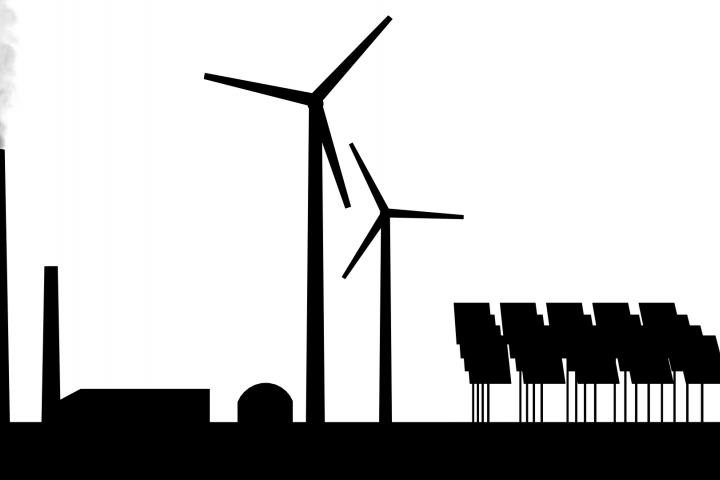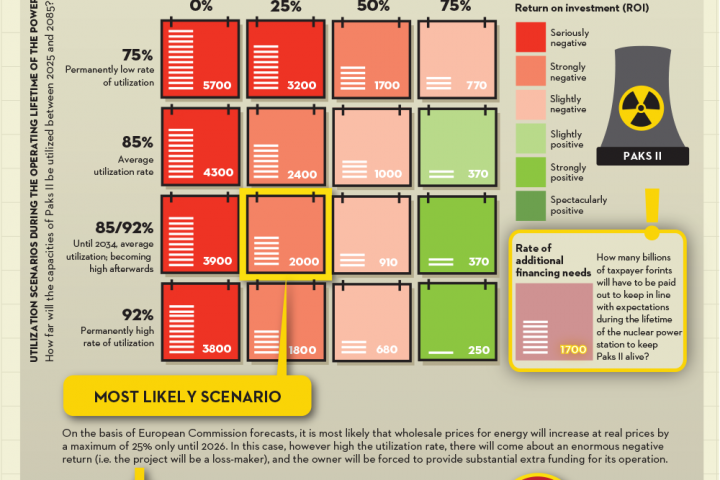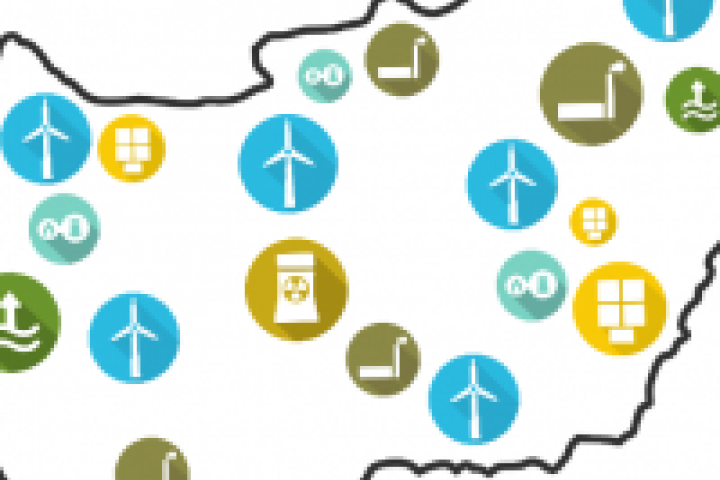Cracks a little, oozes a little, but it’s ours - The Püspökszilágy Atomic Graveyard
Immense background radiation, high activity waste in the storages, toxic waste leakage into the ground water - such news got through to us from several sources apropos of the waste disposal facility in Püspökszilágy.
It wasn’t an easy task for us to deal with sorting out the often contradictory information, and untangling the threads. For this, beside of the site visit, we collected and processed hundreds of pages of official reports, minutes and resolutions. Some of them were publicly available, others were requested from authorities by the locals, and we also issued several freedom of information requests.
The processed information and data partly proved the aforementioned rumors, and partly didn’t. The official reports clearly confirmed that for approximately 15 years, tritium and recently also radiocarbon has been leaking to the environment from the storage facility. However, it is still not that clear how significant the problem currently is, and what exactly can be expected in the near future.
What is going on in Püspökszilágy?
One of the most useful readings for us proved to be the new test material report, requested by us, that was submitted by the company that operates the Püspökszilágy disposal site on December 31, 2018, to the Hungarian Atomic Energy Authority. The report confirmed our former clues that tritium level of the ground water of the monitoring wells onsite has been rising from the early 2000s.
However, novelty was for us that beside the level of tritium, the level of radiocarbon has also increased in the past few years. All of this indicate that radioactive materials emerge to the environment from the radioactive waste and the disposal.
|
Tritium and radiocarbon Tritium is a modification form of hydrogen (so-called isotope), radiocarbon is for carbon. These isotopes natural occurrence on Earth is very slight. Both of them are radioactive therefore-despite of the dose- can increase the risks of cancer diseases. Tritium is very itinerant in so it is capable of extremely quick spread. For the tritium content of drinking water threshold limits are assessed which are surprisingly divergent by countries. In the European Union the limit is 100 Bq/liter, while in other countries it is 7000 Bq/liter or 30.000 Bq/liter. Recommendations although coexist for the induction of the 20 Bq/liter threshold limit. |
Implicitly this shouldn’t be like this. It is indispensable to store radioactive waste in a way that radioactive substances cannot leak into the ground, to the water or to the air. Namely for example if they get into the ground water and from that into the water cycle it can be dangerous for the locals who gets in contact with the contaminated water.
Luckily according to the reports higher levels of tritium and radiocarbon was only measured onsite thus far. For the present, limit exceeded outside of the disposal isn’t traceable during the samplings, for example in the nearby Szilágyi-stream or in the driking water.
This is indeed good news in the matter of the current state but the problem is that in the point of future there are many uncertainties. Namely there are contradictions between the different expert examinations and results of the models for example in how the ground water stirs onsite and in exactly how tritium spreads. On the grounds of this we presume that for the future actually no one can predict properly where and how long these radioactive materials can get in the neighborhood.
|
What is that we don’t know about the tritium/radiocarbon situation at Püspökszilágy according to the PURAM report?
Source: Comprehensive assessment of the increase in tritium and radiocarbon activity concentration observed at the Püspökszilágy Radioactive Waste Processing and Storage Facility and a proposal for a further testing program, PURAM, December 2018. |
What is stored at Püspökszilágy?
The disposal was built in order to place the Hungarian generated small- and medium activity radioactive waste there. Such waste produced in the industry and of course at the Paks Nuclear Power Plant in a large measure. In 1976 they could not reckon with Paks NPP since it was built later. However between 1983 and 1996 great amount of nuclear waste was transported here from Paks. So in contrast with the original plans approximately 45 percent of the 5 thousand m3 waste originates from Paks.
“Curiosity” is that when the construction of the facility was authorized it was not stabilized what type and form of nuclear waste can be accepted, namely stored. Thus for a while they took all the waste they had been given and placed them in the form the waste was shipped. For example like this:

The first waste acceptance and disposal requirements were only made in the early 2000s, after nearly 30 years of operation. (!) This is why it could occur that at the present time such waste exist in the pools of the disposal which according to today's safety standards could only have been taken over for temporary storage. Long-lived radioactive waste is such. For the final storage of these the Püspökszilágy disposal is not sufficient.
|
Low-activity waste is defined as any waste with a radiation dose of less than 0.3 mSv/h at 10 cm from its surface, whereas high-activity waste has a radiation dose greater than 10 mSv/h. Long-lived fission products are those having a half-life of more than 30 years. Half-life refers to the time during which half of the radioactive atoms in the material decay. Half-life of tritium (3H) is 12, 3 years; half-life of radiocarbon (14C) is 5730 years. Thus in the case of tritium only half of the original number of radioactive atoms will be present in 12 years, quarter in 24 years and so on. However, radiocarbon has the same amount of radioactive atom for 5730 years. |
What causes the “leaking”?
According to the reports the primary reason for the tritium- and radiocarbon leaking is that inadequate waste forms are stored in the disposal. Its main sources are the waste packaged in plastic bags, ampoules containing liquids or gaseous substances and soaked organic solvents. But they don’t know exactly.
On one hand there is some uncertainty as to whether the type of waste to be discarded has been properly documented in 30-40 years, that is and also whether it is actually in the repositories what is listed in the registers.
The other problem is the packaging. On one part it was not necessarily appropriate at the first place, e.g. plastic bags are not really timeless and modern technique for packaging nuclear waste. Contrary it is unknown what state are they in currently in so for example if the plastic bags have split. According to the official reports we requested “a large part of the waste that has already been deposited is unlikely to meet the applicable waste disposal requirements.”
Nevertheless most likely the vitiated state of the disposals and the structural shortcomings are also contributed to the problem. While the original plans are known neither the realization design nor the construction quality assurance protocol are available. However in an earlier examination at the surrounding of the pools rapidly increased cracks were observable and the pools and the waste were watering. These things can contribute to the leaking of certain materials from the waste packages to the environment. Although no one knows exactly what part of which waste package originates tritium and radiocarbon and precisely what is the reason of the leaking.
What is next?
Previously deposed waste at the facility which form and compound is inadequate or is long half-life has to be taken out from the disposal, needs to be re-packaged and only those waste can be replaced again for which the repository is technically suitable for the final storage. All the rest, for example the long lived waste will only be stored here temporary.
The first period of this program took place between 2007 and 2009, the second period only just started. In pursuance of the information by PURAM it will take 15-20 years to take out, re-measure, repackage and place properly all the waste. As the company expects the repackaging program will help the problem of tritium and radiocarbon but they cannot affirm that for sure that it will completely eliminate the phenomenon.
However the question that arises in us is how we want to build a safe storage for thousands of years while we cannot even build a concrete pit without cracking it in 40 years…
|
Background radiation More or less radioactive radiation reaches us always and everywhere at the Earth. This is partly natural radiation from the Earth's crust and the cosmic space. On the other hand it is artificial origin, radioactive radiation emitted by building materials or nuclear explosions and facilities. (E.g. the additional radiation from the Chernobyl disaster is still demonstrable.) The degree of background radiation is variant depending by countries, lands, altitude and built environment. According to the data of the radiation measurement system by the National Directorate General for Disaster Management, for example this is how the background radiation looked like in Hungary in the morning of January 27, 2019 at the places meters: Source: Ministry of Interior National Directorate General for Disaster Management, 27 January 2019, 9:20 * Approximate value for Püspökszilágy, which we could read from the graph published by PURAM. The meter at the Püspökszilágy disposal measures slightly higher radiation than most of the settlements. But according to the released data it is not typical here either for the radiation to reach the warning level: National Directorate General for Disaster Management treats the level of radiation normal until the limit 250 nSV/h. Above this an alert level is triggered when the system is signaled to central bodies and increased attention has to be paid to the given station. If the radiation level exceeds 500 n Sv / h the authority should start investigating the case. It is interesting for example that the level of radiation in Paks is lower because the soil in the floodplain is continuously washed away by the Danube, including the radioactive materials contained therein. For the raising of the locals of Püspökszilágy, according to our information, the installation of a background radiation meter in the village is ongoing. As we know this year the National Directorate General for Disaster Management will place two meters in the area that will be connected to the system mentioned above, so the data can be tracked online. As we know the building of such station is about 10 million forints. In addition, PURAM also say that they will place a meter in the center of Püspökszilágy, where it will be possible to track the radiation on the spot. |
The material collected and used in this article were collected in this folder.






